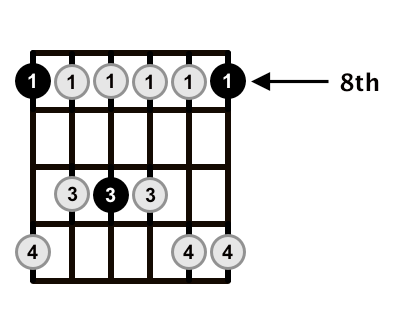In the previous lesson we discussed what scales are, why they’re important, and the many benefits of learning them well. We focused on major scales, because they are in a sense, the ‘master scale’. In this lesson, we are going to look at another scale – the ‘minor pentatonic scale’, so that we can explore lead guitar playing.
What Is Lead Guitar?
When you see/hear a guitarist playing chords, they’re playing ‘rhythm guitar’. When you see/hear a guitarist doing a guitar solo, that’s lead guitar. Ok, that is a very simple explanation, but it’s a good starting point. The truth is that the lines are often blurred, a guitarist can often play a song or a part that contains both lead guitar and rhythm guitar elements.
That aside, lead guitar is strongly associated with guitar solos and melodic playing. Guitar solos and melodies are strongly associated with scales, because we use scales as tools to build guitar solos. One of the easiest and most usable scales for lead guitar, is the minor pentatonic scale.
What Is The Minor Pentatonic Scale?
The Minor Pentatonic scale is a five note scale. If we look at its interval structure, it goes like this:
- minor 3rd (3 semitones) – tone – tone – minor 3rd – tone
You can practise playing the scale on one string, as we did with the major scale in the previous lesson. For example, playing a B minor pentatonic scale, by starting on the 2nd fret of the 5th string would look like this:

Using The Major Scale To Produce The Minor Pentatonic
You can use the interval structure to figure out the minor pentatonic scale in every key, just like with the major scale. However, looking at the interval structure is only one way of identifying with a scale. A more commonly used method is to relate any scale back to the major scale, in terms of numbers. We did this briefly in the previous lesson, using the ‘natural minor’ scale as an example. Now we’re going to do it with the minor pentatonic scale. Using this method, we can say that the minor pentatonic scale is made up of the following:
- 1 (root) – b3 – 4 – 5 – b7
What this translates to is that the minor pentatonic scale is made up of the following:
- 1st note of the major scale (1)
- 3rd note of the major scale, lowered by a semitone (b3)
- 4th note of the major scale
- 5th note of the major scale
- 7th note of the major scale, lowered by a semitone (b7)
Let’s do some examples.
The C major scale contains the following notes:
- C – D – E – F – G – A – B
Therefor the C minor pentatonic scale contains the following notes:
- C (1) – Eb (b3) – F (4) – G (5) – Bb (b7)
As you can see, by knowing the C major scale and the makeup of the minor pentatonic scale, we are able to determine the notes of the C minor pentatonic scale.
Let’s do one more example.
The A major scale contains the following:
- A – B – C# – D – E – F# – G#
Therefor, the A minor pentatonic scale contains the following:
- A (1) – C (b3) – D (4) – E (5) – G (b7)
It’s important to note that when you lower any sharp (#) by a semitone, it becomes a natural, not a flat (b). For example, ‘C#’ becomes ‘C’.
G# becomes G.
Learning Scale Shapes:
We have spent a bit of time in the previous lesson and in this lesson explaining the theory behind scales – knowing their interval structure, exploring the names of the notes inside scales etc. This is very important theory. However, as guitarists, we have the luxury of being able to learn movable shapes. If you have already explored the scales page of this website, you will probably already know what I’m talking about. Playing a scale on one string only is a good way of getting a visual idea of how the scale is set out. The problem is that it is not very practical. A far more practical approach is to learn a scale so that it can be played in one position, which allows us to stay in one spot (more or less).
If you know the theory (which you do, right?) you can figure out how to play scales in a given position. It’s a good thing to do, as an exercise in fretboard knowledge and scale knowledge. But I’m not going to suggest that you reinvent the wheel every time you want to play a scale. Sometimes, it’s best to understand the theory and then just learn the shapes that have already been prepared.
Minor Pentatonic Scale Shape
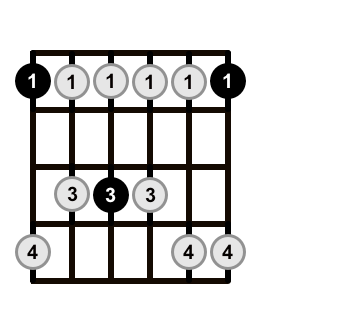
The picture above is a scale diagram of, in this case, the minor pentatonic scale. It is set out the same as a chord diagram, but we interpret it a little differently. If you need a recap, here it is:
- The frets are set out vertically, with the 1st fret at the top.
- The strings are set out horizontally, with the 6th string to the right and the 1st string to the left.
- The circles with numbers tell us to use that finger (number) on the string and fret that it sits on.
- The darker circles represent the root notes
Observe the following picture with markings:
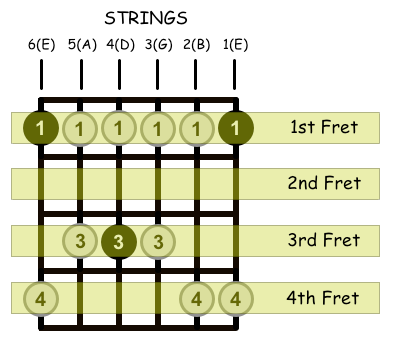
The main difference between scale diagrams and chord diagrams is that with chord diagrams, we play all of the notes in the diagram at the same time, whereas with scale diagrams, we play each note one at a time.
How to Interpret Scale diagrams
If we want to interpret a scale diagram by playing the scale over one ocatave, we do the following:
We start with the lowest root note (pitch-wise). We then move through the notes in order of pitch, until we reach the root note again (up one octave). It would probably be too confusing to try to explain this process note by note. The following diagrams should clearly illustrate how to interpret scale diagrams. The first image is the original pentatonic scale diagram. The second image contains numbers (in red) that tell you in which order to play each note.


If we played the above scale diagram starting on the 1st fret, we would be playing the following:

I specified starting on the 1st fret, because as I mentioned earlier, scale diagrams are movable, which means we can start on any fret we want, depending on which key we want to play in. In the example that we just played, the first note was F, because we started on the 1st fret (1st fret, 6th string = F). We therefor played an ‘F minor pentatonic scale’.
We could however, start on the 5th fret. While our scale diagram would stay the same, our interpretation of where it is played would be as follows:
The text that says ‘5th’ indicates that the scale should be played starting on the 5th fret.
The root note would now be ‘A’, as the 5th fret of the 6th string is an ‘A’. This means that we would now be playing an ‘A minor pentatonic scale’:

If we started on the 8th fret, we would be playing a ‘C minor pentatonic scale’:
Ok, you should by now have a clear understanding of how scale shapes work and how you can move them around. You should also know how to play the minor pentatonic scale in any key over one octave. Nice work. It’s time to introduce another shape. Same scale, different shape.
Why We Use Different Shapes To Play The Same Thing
The first shape that we looked at allows us to play the minor pentatonic scale. Because it is movable, we are able to use it to play the minor pentatonic scale in all 12 keys. So why do we need more shapes that simply allow us to play the same thing? Because learning new shapes allows us to play the same scale, in the same key, but in a different position. Let’s take the first shape that we looked at for example.
If we want to play an F minor pentatonic scale using that particular shape, we have to play it by starting on the 1st fret. We could play the same shape in a different position if we want, but we would be changing the key. For a more practical example, imagine that you are soloing using the F minor pentatonic shape that we have learnt (starting on the 1st fret). You feel that you need to go higher up the neck, so that you can belt out those high, squealing notes and raise the intensity of your solo. Without learning any other shapes, you can’t really move out of your current position.
By learning multiple shapes for the same scale, we can play one scale, in one key, in different positions all over the fretboard.
Let’s look at another way of playing the minor pentatonic scale.
With the above shape, it’s important to observe that the lowest note of the shape is not the root note. When we interpret the shapes and play them on the guitar, we want to start from the root note, usually the lowest one pitch wise. This was easy with the original shape that we looked at because the lowest note of the shape was the root note, but with this one, we need to observe where the lowest root note is, and play from there. The shape with markings in red (that indicate note order) looks like this.
Keep in mind that while this is a different shape than the original one, it is the same scale – minor pentatonic. It is essentially just a different shape, with a different starting note.
If we were to play this shape by starting on the 1st fret (5th string), it would look like this:

Since the 1st fret of the 5th string is a ‘Bb’, the above scale is a Bb minor pentatonic scale.
As you’ve probably figured, this is a moveable shape as well. Because we play this shape by starting on the 5th string, you need to know the notes along the 5th string in order to know which key you are in. If we played this shape by starting on the 4th fret (for example), we would be playing a ‘Db minor pentatonic scale’.
Of course, now that we know two different shapes for the same scale, we can play the same scale, in the same key, in two different positions. Let’s say we wanted to play the G minor pentatonic scale. If we used the first shape, we would need to start on the 3rd fret of the 6th string, because that note is a G. We could then play the second shape by starting on the 10th fret of the 5th string, as that note is also G. This is how the two shapes would look:


Here are the notes/tabs for the G minor pentatonic scale, using the 1st shape, then the 2nd:


While being able to move shapes around is one of the perks of being a guitarist (if you learn one shape, you can move it around in twelve different keys), the downside is that for every scale you learn, you should be able to play it using different shapes, so that you cover the entire fretboard. So for each scale that you learn, how many different shapes should you learn?
Introducing The CAGED System
The answer is five. If you learn five different shapes for a given scale, you can play that scale all over the fretboard.
The name ‘CAGED’ is derived by associating each of the five shapes with a corresponding chord shape (C + A + G + E + D = CAGED). However, I prefer not to use these labels, as it can be confusing. I think it’s easier just to know that you should learn each scale five different ways and by doing so, you will be effectively using the CAGED system.
The Five Shapes
Let’s look at the five different positions of the pentatonic scale. Although I’m giving them labels, such as ‘Shape 1’ etc, these are just temporary labels. The shape that you play first, depends on which key you are in:
Shape 1
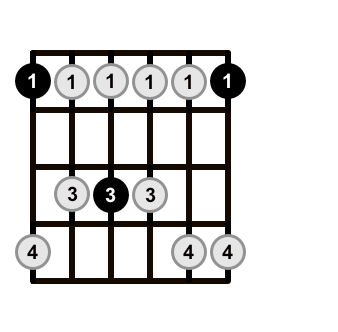
Shape 2
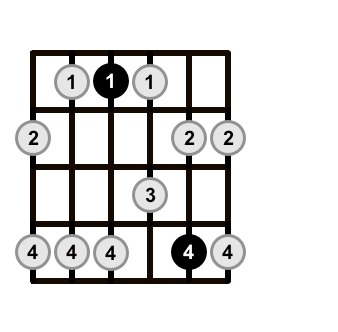
Shape 3
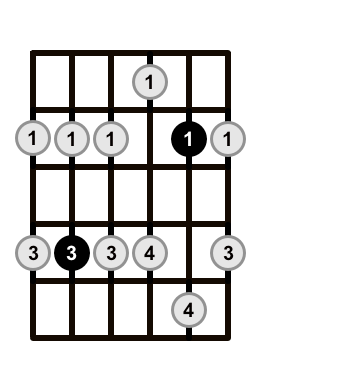
Shape 4
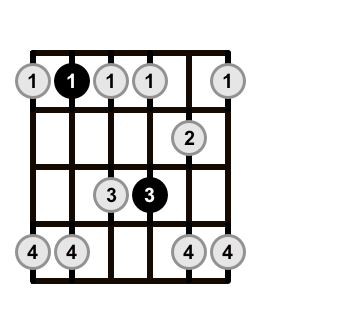
Shape 5

The best way to practise the shapes is to choose a key and play each shape in that one key. Playing each shape over one octave, in the key of G would look like this:
Shape 1

Shape 2

Shape 3

Shape 4

Shape 5

You should be able to hear as you are playing each shape, that the key does not change, yet you are moving higher and higher up the fretboard.
What About All The Other Notes?
You’re probably wondered what we do with the other notes in the diagrams that we have so far left out. Because we have used each shape to play over one octave, there are notes in each shape that we simply haven’t covered. In actual fact, we should play these notes when practising each shape. A lesson already exists on how to do this, called how to practise scales by staying in one position. It’s worth reading. In fact, it’s imperative reading.
We’ve covered a lot of theory in the last two lessons. But it’s well worth it. Being able to play scales up and down the fretboard opens up a whole world of endless possibilities for lead guitar playing. We haven’t really looked at the uses for the pentatonic scale just yet, but we will do that in the next lesson. In the next lesson we are going to look at soloing and improvising using pentatonic scales.
Further reading
- Scales Page – Now that you can interpret scale diagrams, check out the others on the scales page.
- 5 positions for the major scale – In the previous lesson, we looked at major scales, but didn’t look at them in the context of the CAGED system. Now that you understand what it is, it’s worth learning the major scale in 5 positions too.
- Major and Minor Pentatonic Scales – We’ve looked at minor pentatonic scales, but major pentatonic scales are also very useful and closely related to minor pentatonic scales. This lesson compares the two, and provides links to individual keys.
- How To Practise Scales And Arpeggios By Staying In One Position – The same page that I linked to earlier on. It’s a very important lesson.


